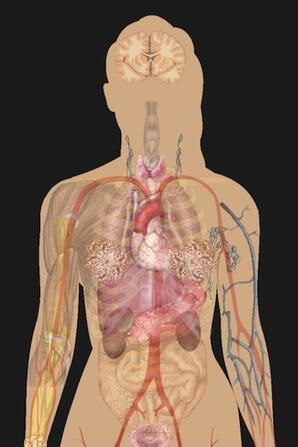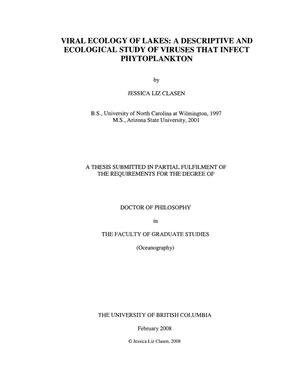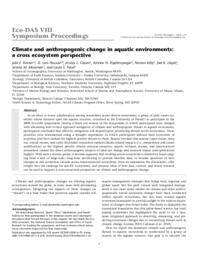Clasen, Jessica
Person Preferred Name
Jessica Clasen
Person Alternate Names
Jessie Clasen
Jessica L. Clasen
Position
Faculty Member
Field of Activity
Aquatic Microbial Ecology
Oceanography
Marine Biology
Microbiology
Email/Contact
clasenj@douglascollege.ca
Department
Status
current
Education and Credentials
PhD (University of British Columbia)
MSc (Arizona State)
BSc (University of North Carolina at Wilmington)
Institute of Urban Ecology Director.
PhD (University of British Columbia)
MSc (Arizona State)
BSc (University of North Carolina at Wilmington)
Institute of Urban Ecology Director.
Related Works
Content type
Digital Document
Abstract
This textbook is a project under development by our Biology faculty to ultimately provide students with all the factual information they need to succeed in the BIOL 1203 and BIOL 1209 courses at Douglas College in BC, Canada. It was developed initially as an adaptation of the OpenStax Anatomy & Physiology textbook, freely available online at http://cnx.org/content/col11496/latest/. The original adaptations of that OpenStax textbook for Douglas College are accessible online at https://pressbooks.bccampus.ca/dcbiol11031109/ and https://pressbooks.bccampus.ca/dcbiol12031209/ In the first edition of the Douglas College adaptations the chapter and section numbers were left as they were in the version of the OpenStax A&P textbook, from which they were largely drawn. However, this second edition has been more extensively edited and rearranged to correspond with the curriculum used at Douglas College, so chapter and section numbers are no longer aligned specifically with the OpenStax A&P textbook.
Origin Information
Content type
Digital Document
Abstract
Since the 'discovery' of the high abundance of viruses in aquatic environments, it has been generally assumed that viruses in lakes are similar to those in oceans. I directly compared these two systems using a large, robust data set. Viral abundance was significantly different among the surveyed environments. The relationship between viral and bacterial abundance indicated a fundamental difference between lakes and oceans, and suggested that viruses infecting phytoplankton may be more important in lakes. Molecular techniques (PCR & DGGE) were used to document spatial and temporal variations in the richness of viruses that infect eukaryotic phytoplankton (Phycodnaviridae) in lakes at the Experimental Lakes Area (ELA). Phycodnavirus richness was highest in the eutrophic lake, and during the spring/early summer in all the lakes. Viral richness was closely associated with phytoplankton abundance and composition. As a result, richness was influenced by trophic status, while patterns of richness were affected by regional climatic conditions. Phylogenetic analysis of environmental Phycodnavirus DNA polymerase (pol) sequences indicated that freshwater Phycodnaviruses are genetically different from cultured isolates and marine environmental sequences. A genetic distance analysis indicated that pol sequences > 7 % different infected different host species. Therefore, the 20 different freshwater sequences likely infected nine different hosts. Multivariate statistics identified seven possible phytoplankton hosts, including chlorophytes, chrysophytes, diatoms and dinoflagellates. Finally, the modified dilution experiment was evaluated as an approach for estimating viral-mediated phytoplankton mortality in two lakes at the ELA. Experiments resulted in non-significant apparent growth rate regressions. While a model analysis, indicated that the method was sensitive to poorly constrained parameters such as burst size and length of the lytic cycle, making it unsuitable for estimating mortality rates in these lakes. These studies indicate that Phycodnaviridae are a genetically rich and dynamic component of lakes. Their richness is influenced by both the chemical and physical components of their environment. Although the presence of these viruses indicates that they are a source of phytoplankton mortality, the magnitude of their impact on structuring phytoplankton communities awaits methodological advances. Nonetheless, these findings support the view that viruses infecting phytoplankton are ecologically important components of lake ecosystems.
Origin Information
Content type
Digital Document
Abstract
The chapter, "Climate and anthropogenic change in aquatic environments: A cross ecosystem perspective" was written by the listed authors including Jessica L. Clasen (Douglas College Faculty). The Ecological Dissertations in the Aquatic Sciences (Eco-DAS) symposia bring together 35-40 recent PhD recipients for one week in alternate years. Eco-DAS VIII was held in 2008. Eco-DAS is sponsored by the Center for Microbial Oceanography: Research and Education (C-MORE), the University of Hawai`i School of Ocean and Earth Science and Technology (SOEST) and its Department of Oceanography, and the Association for the Sciences of Limnology and Oceanography (ASLO). The Proceedings of Eco-DAS VIII includes nine chapters published in open access.
In an effort to foster collaboration among researchers across diverse ecosystems, a group of early career scientists whose interests span the aquatic sciences, convened at the University of Hawai’i to participate in the 2008 Eco-DAS symposium. During a break out session of the symposium in which participants were charged with discussing how to best approach mitigation of climate and anthropogenic threats to aquatic ecosystems, participants concluded that effective mitigation will depend upon prioritizing threats across ecosystems. These priorities were documented using a thought experiment in which participants defined their ecosystem of expertise, and then ranked the highest-priority threats to them. Results revealed that marine (open ocean, deep sea, coastal oceans, and rocky intertidal) researchers ranked climate-related impacts (i.e., temperature and ocean acidification) as the highest priority threats whereas estuarine, marsh, wetland, stream, and lake/reservoir researchers ranked the direct anthropogenic impacts of land-use change and nutrient inputs (eutrophication) highest. With such a diverse group, it became apparent that working across ecosystems is limited by issues rang- ing from a lack of large-scale, long-term monitoring to provide baseline data, to broader questions of how changes in one ecosystem cascade across interconnected ecosystems. Here we summarize the discussions, offer insight into the rankings for specific ecosystems, and propose ideas of how past, current, and future research can be used to support a cross-ecosystem perspective on climate and anthropogenic change.
Origin Information
Content type
Digital Document
Abstract
The possibility of P limitation for zooplankton growth has many implications for understanding changes in production efficiency and feedback dynamics between consumers and resources. However, there have been no direct tests to determine whether the putative P limitation is real. To answer this question, we directly supplied inorganic P to Daphnia magna apart from food algae, Scenedesmus acutus, and then examined changes in body mass. During the period from birth to age 6 d, D. magna were fed on live algae for 19 h and placed in water of high inorganic P (4 mM: P treatment) for 5 h each day. We used P‐free water as a control treatment. Growth rate estimated from initial and final body mass during the 6‐d incubation was significantly larger in the P treatment than in the control treatment when Daphnia fed on P‐deficient algae, whereas a significant difference was not detected between the treatments for Daphnia fed on P‐sufficient algae (C : P atomic < 300). The results clearly demonstrate that Daphnia growth is in fact limited by P itself when they feed on P‐deficient algae.
Origin Information
Content type
Digital Document
Abstract
Incident light was manipulated in large plankton towers containing algae, microbes, and herbivores. Paradoxically, food chain production was lower with greater light energy input. This apparent paradox is resolved by recognizing stoichiometric constraints to food chain production. At high light, elevated algal biomass was achieved mainly by increases in cellular carbon. Consumers have a high phosphorus demand for growth, and thus a large excess of carbon inhibited, rather than stimulated, their growth. These experiments may help us predict the consequences of anthropogenic perturbations in nutrients, carbon, and solar energy. They also may help us to understand the wide range of consumer biomass and production at a given level of primary productivity in ecosystems. [ABSTRACT FROM AUTHOR]
Origin Information
Content type
Digital Document
Abstract
1. We used the freshwater alga Chlorella NC64A (Division Chlorophyta) and its virus Paramecium bursaria Chlorella virus-1 (PBCV-1) as a model system to test for potential stoichiometric constraints on a virus–host interaction. 2. Media phosphorus concentrations were manipulated to create Chlorella NC64A host cells with low (91 ± 23) or high (453 ± 246) C : P ratio. In contrast, the C : P ratio of PBCV-1, calculated from its biochemical composition, was 17 : 1. 3. Stoichiometric theory predicts that infection success and postinfection viral production should be depressed in high C : P cultures due to insufficient intracellular P for production of P-rich viral particles. 4. Consistent with this hypothesis, viral production was strongly affected by host C : P ratio. While host C : P ratio did not affect viral attachment or the percentage of new viral particles that were infectious, in the low C : P Chlorella NC64A treatment, nine times more viruses were produced per infected cell than in the high C : P treatment (158 ± 138 versus 18 ± 18), indicating that the low C : P cells were higher quality for PBCV-1 proliferation. 5. This result implies that the stoichiometric quality of algal cells can have a major effect on host–virus population dynamics. [ABSTRACT FROM AUTHOR]
Origin Information
Content type
Digital Document
Abstract
Interactions between trophic levels during food web assembly can drive positive correlations in diversity between producers, consumers, and decomposers. However, the contribution of trophic interactions relative to local environmental factors in promoting species diversity is poorly understood, with many studies only considering two trophic levels. Here we examine correlations in diversity among zooplankton, phytoplankton, and bacteria in the pelagic zone of 31 lakes in British Columbia, Canada. We sampled species diversity of zooplankton and phytoplankton through morphological identification, and bacterial genetic diversity was estimated by denaturing gradient gel electrophoresis (DGGE) of 16S rDNA polymorphisms. We looked for correlations in diversity that were independent of the abiotic environment by statistically controlling for 18 limnological variables. No significant correlations were found between the diversity of zooplankton, phytoplankton, and bacteria. In addition, the physical factors that were associated with species composition in one trophic level were independent of those that were important for another. Our results provide no support for the importance of direct feedbacks between producers, consumers, and decomposers in maintaining diversity. Zooplankton, phytoplankton, and bacterial diversity and composition are regulated independently from one another and respond to different environmental variables. These results suggest that species of lake plankton show loose trophic associations with one another due to broad diets in consumers and decomposers.
Origin Information
Content type
Digital Document
Abstract
1. Samples from 16 lakes in central ( n = 145) and western ( n = 12) North America, the coastal northeast Pacific ( n = 302) and the western Canadian Arctic Oceans ( n = 142) were collected and analysed for viral, bacterial and cyanobacterial abundances and chlorophyll- a concentration. 2. Viral abundance was significantly different among the environments. It was highest in the coastal Pacific Ocean and lowest in the coastal Arctic Ocean. The abundances of bacteria and cyanobacteria as well as chlorophyll- a concentrations also differed significantly among the environments, with both bacterial abundance and chlorophyll- a concentration highest in lakes. As a consequence, the association of these variables with viral abundance varied among the environments. 3. Discriminant analyses with the abundance data indicated that the marine and freshwater environments were predictably different from each other. Multiple-regression analysis included bacterial and cyanobacterial abundances, and chlorophyll- a concentration as significant variables in explaining viral abundance in lakes. In regression models for the coastal Pacific Ocean, bacterial and cyanobacterial abundances were significant variables, and for the coastal Arctic Ocean viral abundance was predicted by bacterial abundance and chlorophyll- a concentration. 4. The relationship of viral and bacterial abundance differed between the investigated freshwater and marine environments, probably because of differences in viral production and loss rates. However, freshwaters had fewer viruses compared to bacteria, despite previously documented higher burst sizes and frequencies of infected cells, suggesting that loss rates may be more important in lakes. 5. Together, these findings suggest that there are different drivers of viral abundance in different aquatic environments, including lakes and oceans. [ABSTRACT FROM AUTHOR]
Origin Information
Content type
Digital Document
Abstract
The book chapter, "Isolation independent methods of characterizing phage communities 1: Strain typing using fingerprinting methods" was written by authors: Jessica L. Clasen (Douglas College Faculty) and is located in the book "Bacteriophages. Methods and Protocols (which is volume 2 of the Molecular and Applied Aspects book series). Since most of the phage genomes isolated from natural samples are previously unknown sequences, an isolation-independent approach is necessary to quantify the diversity of natural viral communities. Currently, two different methodological approaches are widely used to obtain genetic fingerprints of natural phage communities. While the separation of different viral genomes with pulsed field gel electrophoresis (PFGE) is based on the size of the genome, denaturing gradient gel electrophoresis (DGGE) uses minor differences in gene base composition to separate fragments of amplified DNA from natural viral communities. Finger printing techniques are a relatively fast and cheap tool to assess the diversity of environmental viruses. Together, PFGE and DGGE provide useful tools to study viral ecology in natural habitats.
Origin Information
Content type
Digital Document
Abstract
Viruses that infect phytoplankton are an important component of aquatic ecosystems, yet in lakes they remain largely unstudied. In order to investigate viruses (Phycodnaviridae) infecting eukaryotic phytoplankton in lakes and to estimate the number of potential host species, samples were collected from four lakes at the Experimental Lakes Area in Ontario, Canada, during the ice-free period (mid-May to mid-October) of 2004. From each lake, Phycodnaviridae DNA polymerase (pol) gene fragments were amplified using algal-virus-specific primers and separated by denaturing gradient gel electrophoresis; 20 bands were extracted from the gels and sequenced. Phylogenetic analysis indicated that freshwater environmental phycodnavirus sequences belong to distinct phylogenetic groups. An analysis of the genetic distances "within" and "between" monophyletic groups of phycodnavirus isolates indicated that DNA pol sequences that differed by more than 7% at the inferred amino acid level were from viruses that infect different host species. Application of this threshold to phylogenies of environmental sequences indicated that the DNA pol sequences from these lakes came from viruses that infect at least nine different phytoplankton species. A multivariate statistical analysis suggested that potential freshwater hosts included Mallomonas sp., Monoraphidium sp., and Cyclotella sp. This approach should help to unravel the relationships between viruses in the environment and the phytoplankton hosts they infect.
Origin Information









